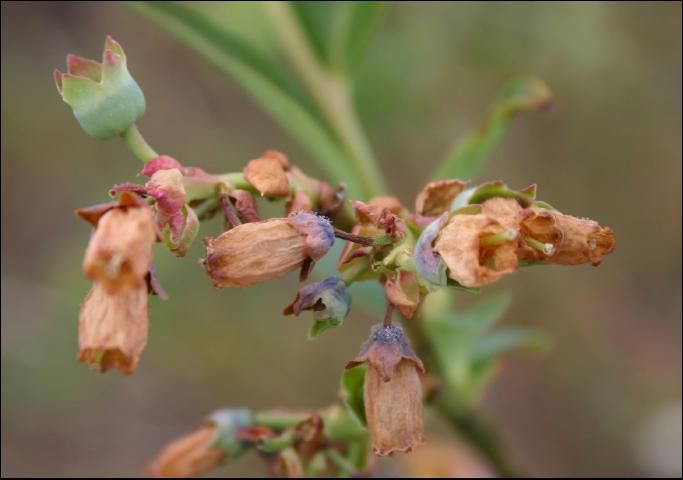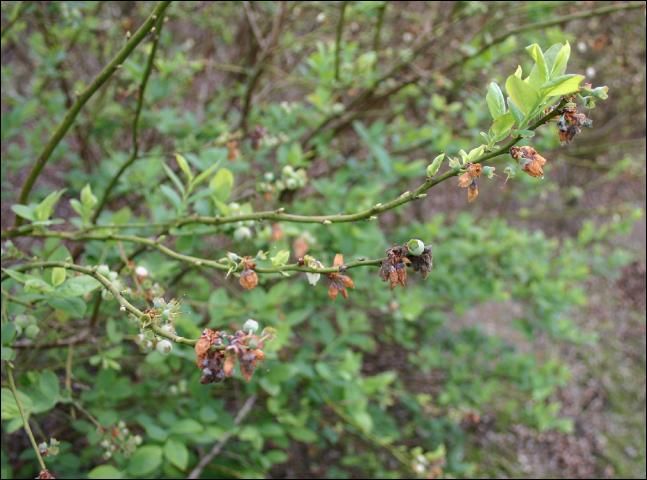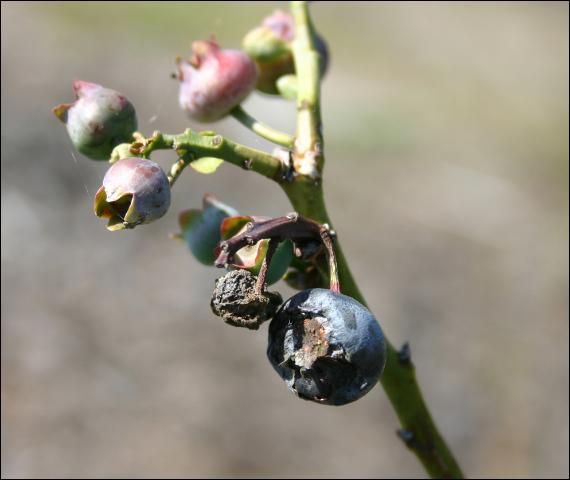Information contained in this publication is intended to help blueberry growers in Florida identify and manage Botrytis blossom blight. For more information, search the Ask IFAS website (https://edis.ifas.ufl.edu) or contact your local UF/IFAS Extension agent (https://sfyl.ifas.ufl.edu/find-your-local-office/).
The Pathogen and Disease Cycle
Botrytis blossom blight is an important disease of blueberries and several flowering ornamental plants. The fungus, Botrytis cinerea, most commonly infects and blights wounded or senescent plant tissues. As a blueberry bush blooms, corollas (the fused petal of the flowers) senesce and become quite susceptible to infection. Ideally the corolla should drop from the flower after pollination but before senescence occurs. Frost damage on tender new growth may wound the plant, delay petal drop, and facilitate infection by the fungus.
The pathogen survives well as a saprophyte (nonpathogenic phase) on dead host and non-crop plant material. Spores of the pathogen are abundant during blueberry bloom most years. Sanitation efforts to remove diseased and infested plant materials are good horticultural practices but would not significantly limit development of this disease.
Botrytis blossom blight can spread from the corolla into the ovary and eventually into the peduncle (stem of the immature berry) (Fig. 1). During periods of high relative humidity, conidia (spores) of the fungus are produced on infected plant parts (Fig. 2). If the blight continues, an entire cluster of berries can be aborted (Fig. 3). When disease is severe, the berry reduction can become economically important (Fig. 4). After pollination of a flower and drop of the corolla, the risk of infection of the developing fruit is reduced.




If progress of the blight is suppressed by environmental conditions, a fungicide application, or by plant defenses, disease progress may stop, but the fungus may lie dormant in the immature fruit. Infected berries are sometimes deformed and may develop further rot if environmental conditions later become favorable for disease (Fig. 5). If the fruit is stored cool and humid for long periods after harvest, the fungus may then cause the gray fuzzy rot commonly observed on blueberries in grocery stores. Because of the relatively short interval from harvest to retail sales in Florida, the fruit rot stage of the disease is not typically a concern.

The development of Botrytis blight, like many other foliar fungal diseases, is highly dependent on environmental conditions. Infection and disease development are favored by extended periods of high relative humidity. Most years, blueberries in Florida are overhead irrigated for freeze protection during bloom. While sometimes necessary, frequent overhead irrigation at this time of year increases the likelihood of Botrytis blossom blight.
Botrytis blossom blight is unusual because disease can occur at a wide range of temperatures. Favorable temperatures can range from as low as 32°F, where growth of the fungus is slow, to over 70°F. During bloom, periods of low temperatures combined with extended periods of high relative humidity result in more-than 24 hours of leaf wetness and increased likelihood of significant disease development.
The severe outbreak of Botrytis blossom blight observed in Gainesville around March 4, 2004 was likely influenced by cool and wet weather. According to Florida Automated Weather Network (FAWN) data from the Alachua location, hourly temperatures between February 24 and 27 were (on average) 9°F lower in 2004 than the average of the hourly temperatures recorded the previous four years. In addition to the unusually low temperatures during this period, the hourly relative humidity remained above 90% for the entire time. In this example, the extended cool and wet period was favorable for disease development.
Disease Management
Blueberry cultivars differ in susceptibility to Botrytis blossom blight, but no one cultivar is completely resistant. In an average year in Florida, the economic loss due to Botrytis can be minimized by limited use of irrigation for freeze protection and judicious fungicide applications. Overhead irrigation extends periods of leaf wetness and favors disease development. Fungicide applications prior to, during, or immediately following extended cool wet periods during bloom can limit early infection. Untreated infections during bloom can lead to disease problems throughout the season. If Botrytis does become established at bloom, fungicide applications later in the season may be required to manage spread of the fungus to ripening berries. Applications at this time are less efficient and less effective for managing this disease than those at bloom.
Fungicides labeled for Botrytis cinerea control on blueberries in Florida and their relative efficacies are listed in Table 1. Captan is familiar to many growers as a cost-effective fungicide that will prevent infection and Botrytis blossom blight development if applied preventatively. Some of the new, site-specific, systemic fungicides listed in Table 1 have provided excellent control in university trials when applied preventatively and curatively (soon after favorable conditions but before symptoms are apparent). However, these new fungicides have not been extensively tested on blueberries in Florida. Resistance to site-specific fungicides is a real concern with this pathogen. Resistance management strategies are included on the labels of products containing site-specific fungicides. Each of the different fungicides in Table 1 has a different mode of action and can be rotated in a resistance management plan. Fungicides should be rotated or used in mixtures with fungicides with different modes of action to help prevent fungicide resistance. Each product's specific label instructions should always be read and followed carefully as changes may have occurred since this text was written. If in doubt, contact your local county agent or university specialist for up-to-date information (http://ifas.ufl.edu/extension-offices-rec-maps.shtml). Products are listed for example only. No endorsement or criticism of any product listed or omitted is intended or implied. Relative efficacy data were taken from results of trials not conducted in Florida.
For additional information concerning fungicide products and other integrated approaches to blueberry production in Florida, see the Florida Blueberry Integrated Pest Management Guide (https://edis.ifas.ufl.edu/hs380).